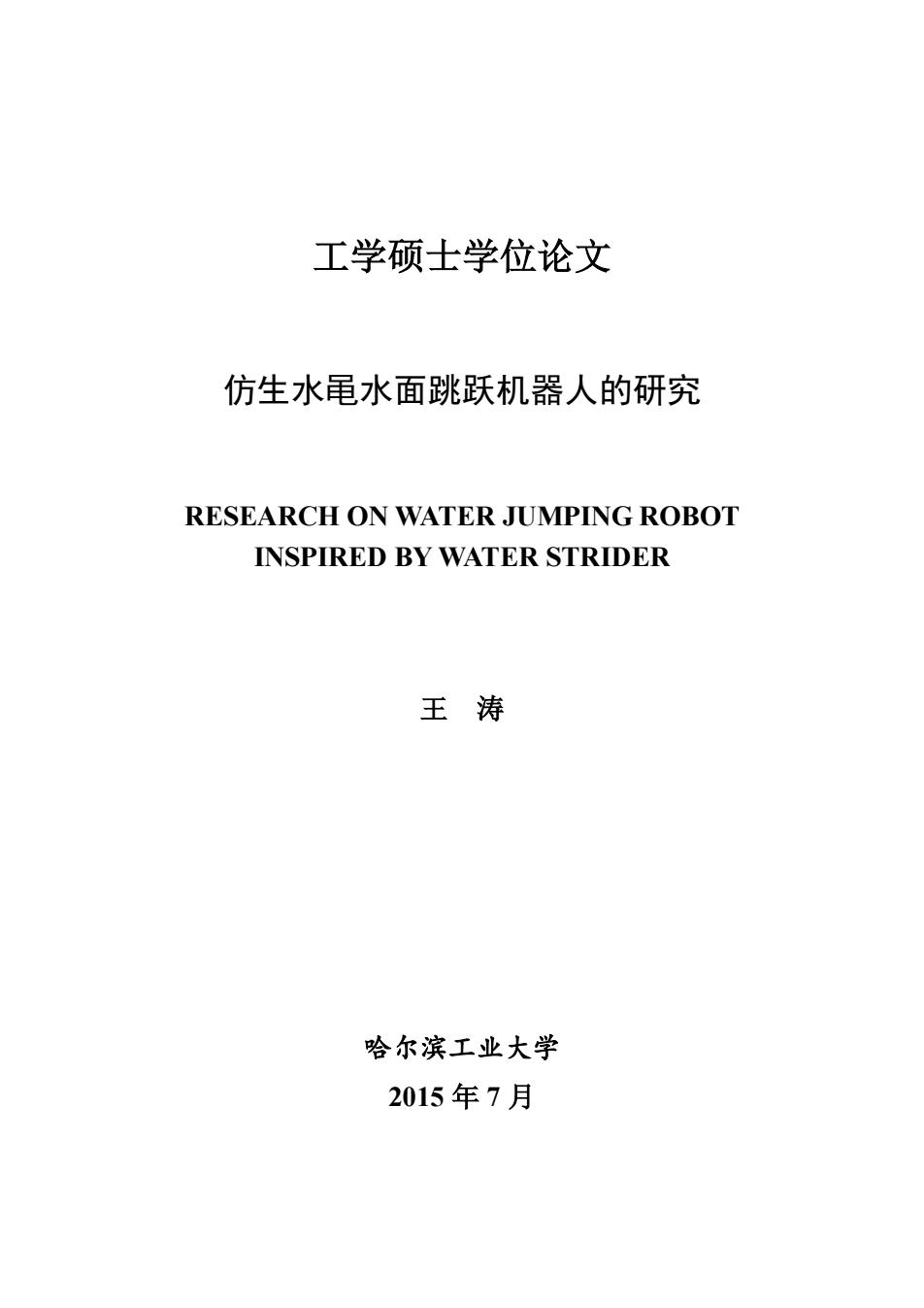
工学硕士学位论文 仿生水黾水面跳跃机器人的研究 RESEARCH ON WATER JUMPING ROBOT INSPIRED BY WATER STRIDER 王涛 哈尔滨工业大学 2015年7月
工学硕士学位论文 仿生水黾水面跳跃机器人的研究 RESEARCH ON WATER JUMPING ROBOT INSPIRED BY WATER STRIDER 王 涛 哈尔滨工业大学 2015 年 7 月
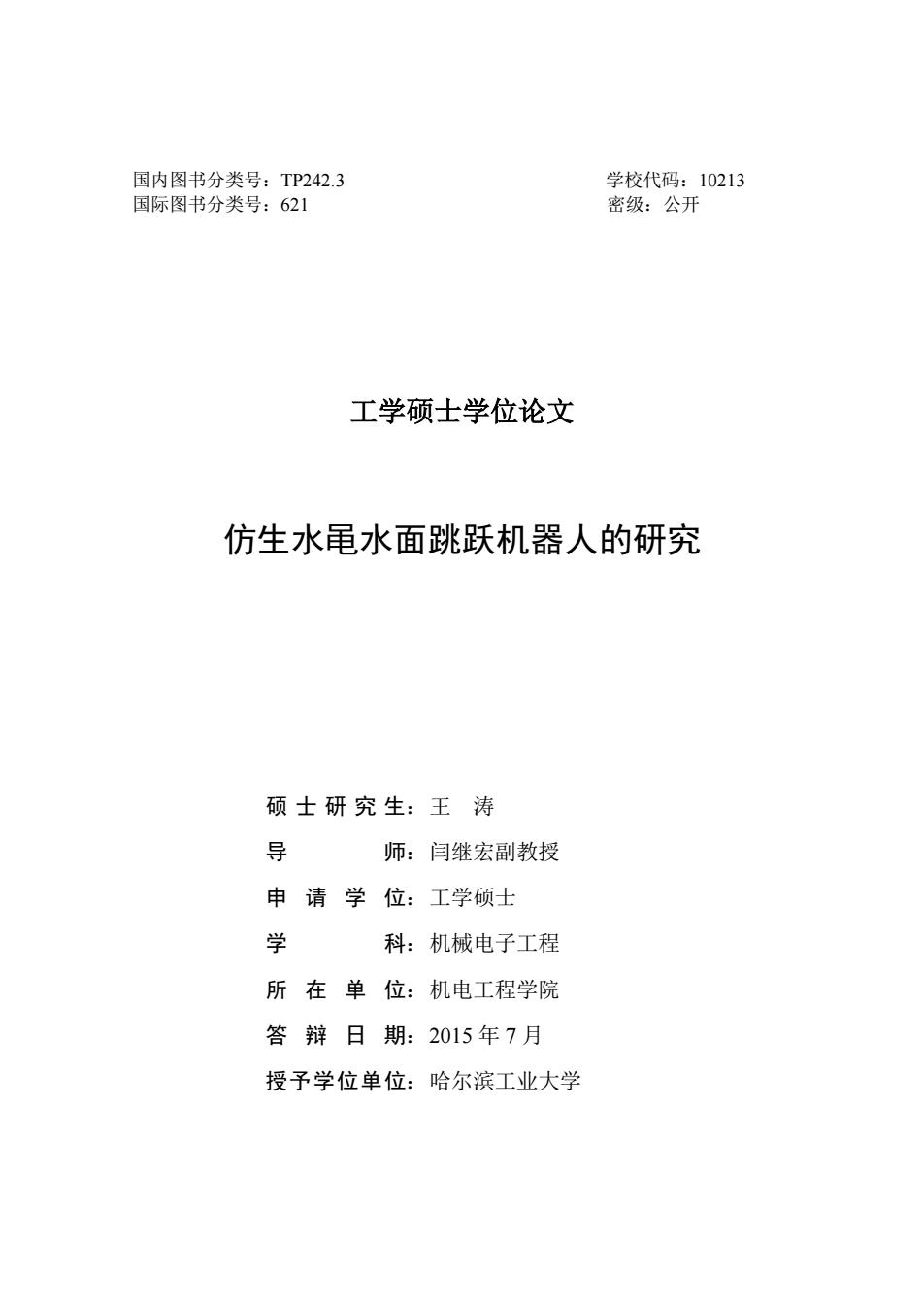
国内图书分类号:TP242.3 学校代码:10213 国际图书分类号:621 密级:公开 工学硕士学位论文 仿生水龟水面跳跃机器人的研究 硕士研究生:王涛 导 师:闫继宏副教授 申请学位:工学硕士 学 科:机械电子工程 所在单位:机电工程学院 答辩日期:2015年7月 授予学位单位:哈尔滨工业大学
国内图书分类号:TP242.3 学校代码:10213 国际图书分类号:621 密级:公开 工学硕士学位论文 仿生水黾水面跳跃机器人的研究 硕 士研究生:王 涛 导 师:闫继宏副教授 申请学位:工学硕士 学 科:机械电子工程 所 在 单 位:机电工程学院 答 辩 日 期:2015 年 7 月 授予学位单位:哈尔滨工业大学
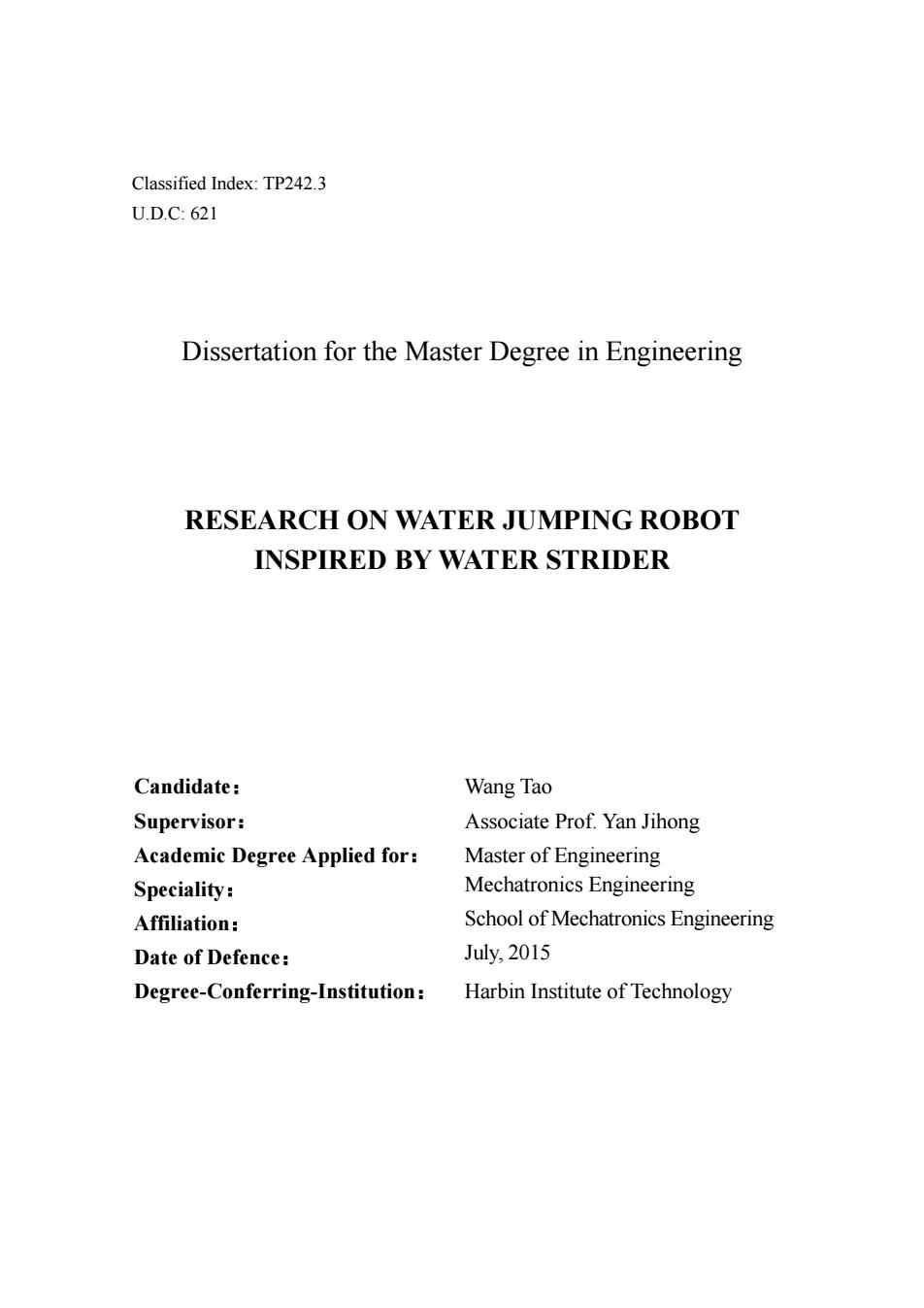
Classified Index:TP242.3 UD.C:621 Dissertation for the Master Degree in Engineering RESEARCH ON WATER JUMPING ROBOT INSPIRED BY WATER STRIDER Candidate: Wang Tao Supervisor: Associate Prof.Yan Jihong Academic Degree Applied for: Master of Engineering Speciality Mechatronics Engineering Affiliation: School of Mechatronics Engineering Date of Defence: July,2015 Degree-Conferring-Institution: Harbin Institute of Technology
Classified Index: TP242.3 U.D.C: 621 Dissertation for the Master Degree in Engineering RESEARCH ON WATER JUMPING ROBOT INSPIRED BY WATER STRIDER Candidate: Wang Tao Supervisor: Associate Prof. Yan Jihong Academic Degree Applied for: Master of Engineering Speciality: Mechatronics Engineering Affiliation: School of Mechatronics Engineering Date of Defence: July, 2015 Degree-Conferring-Institution: Harbin Institute of Technology
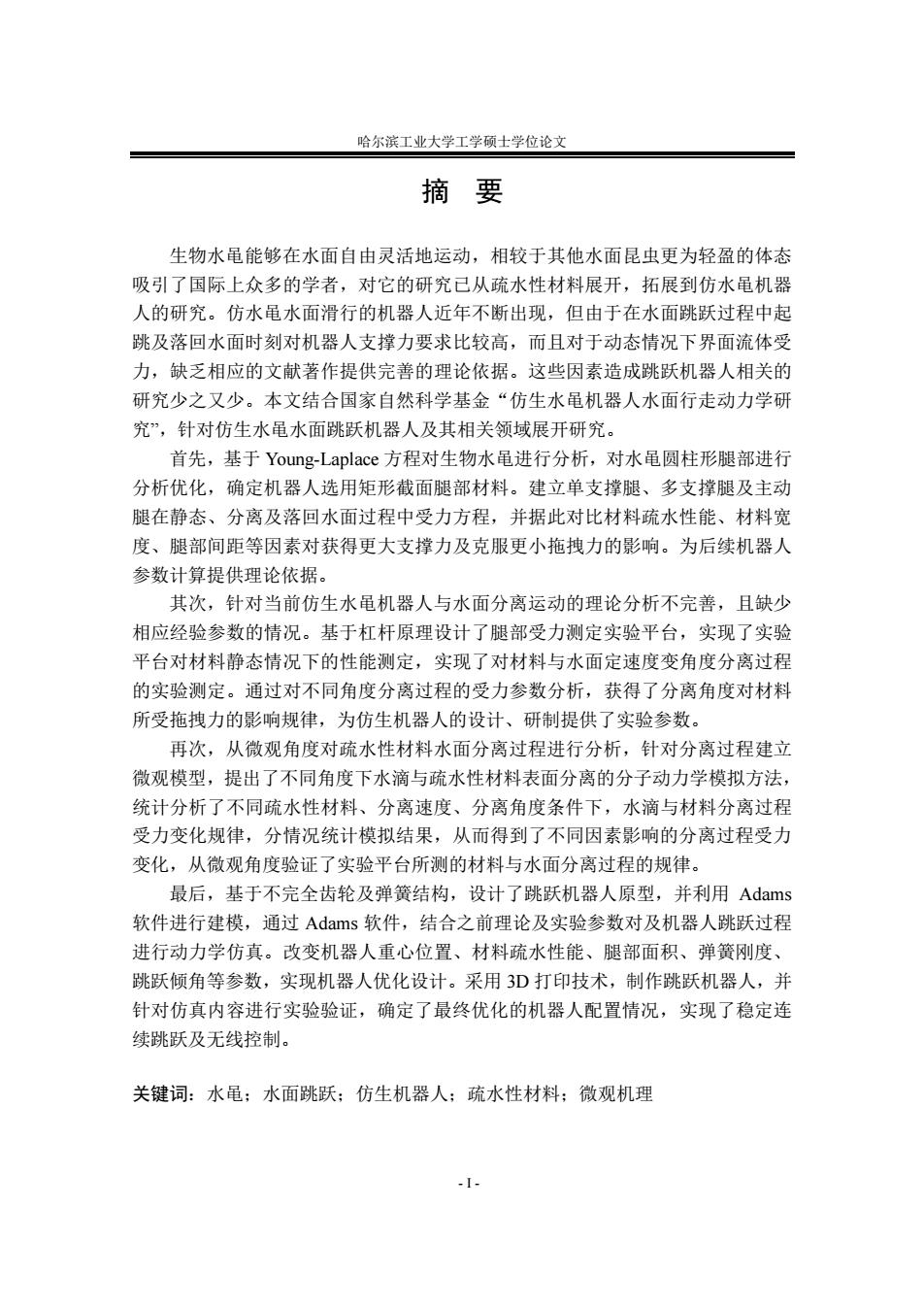
哈尔滨工业大学工学硕士学位论文 摘要 生物水黾能够在水面自由灵活地运动,相较于其他水面昆虫更为轻盈的体态 吸引了国际上众多的学者,对它的研究已从疏水性材料展开,拓展到仿水黾机器 人的研究。仿水黾水面滑行的机器人近年不断出现,但由于在水面跳跃过程中起 跳及落回水面时刻对机器人支撑力要求比较高,而且对于动态情况下界面流体受 力,缺乏相应的文献著作提供完善的理论依据。这些因素造成跳跃机器人相关的 研究少之又少。本文结合国家自然科学基金“仿生水黾机器人水面行走动力学研 究”,针对仿生水黾水面跳跃机器人及其相关领域展开研究。 首先,基于Young-Laplace方程对生物水黾进行分析,对水黾圆柱形腿部进行 分析优化,确定机器人选用矩形截面腿部材料。建立单支撑腿、多支撑腿及主动 腿在静态、分离及落回水面过程中受力方程,并据此对比材料疏水性能、材料宽 度、腿部间距等因素对获得更大支撑力及克服更小拖拽力的影响。为后续机器人 参数计算提供理论依据。 其次,针对当前仿生水黾机器人与水面分离运动的理论分析不完善,且缺少 相应经验参数的情况。基于杠杆原理设计了腿部受力测定实验平台,实现了实验 平台对材料静态情况下的性能测定,实现了对材料与水面定速度变角度分离过程 的实验测定。通过对不同角度分离过程的受力参数分析,获得了分离角度对材料 所受拖拽力的影响规律,为仿生机器人的设计、研制提供了实验参数。 再次,从微观角度对疏水性材料水面分离过程进行分析,针对分离过程建立 微观模型,提出了不同角度下水滴与疏水性材料表面分离的分子动力学模拟方法, 统计分析了不同疏水性材料、分离速度、分离角度条件下,水滴与材料分离过程 受力变化规律,分情况统计模拟结果,从而得到了不同因素影响的分离过程受力 变化,从微观角度验证了实验平台所测的材料与水面分离过程的规律。 最后,基于不完全齿轮及弹簧结构,设计了跳跃机器人原型,并利用Adams 软件进行建模,通过Adams软件,结合之前理论及实验参数对及机器人跳跃过程 进行动力学仿真。改变机器人重心位置、材料疏水性能、腿部面积、弹簧刚度、 跳跃倾角等参数,实现机器人优化设计。采用3D打印技术,制作跳跃机器人,并 针对仿真内容进行实验验证,确定了最终优化的机器人配置情况,实现了稳定连 续跳跃及无线控制。 关键词:水黾;水面跳跃:仿生机器人;疏水性材料:微观机理
哈尔滨工业大学工学硕士学位论文 - I - 摘 要 生物水黾能够在水面自由灵活地运动,相较于其他水面昆虫更为轻盈的体态 吸引了国际上众多的学者,对它的研究已从疏水性材料展开,拓展到仿水黾机器 人的研究。仿水黾水面滑行的机器人近年不断出现,但由于在水面跳跃过程中起 跳及落回水面时刻对机器人支撑力要求比较高,而且对于动态情况下界面流体受 力,缺乏相应的文献著作提供完善的理论依据。这些因素造成跳跃机器人相关的 研究少之又少。本文结合国家自然科学基金“仿生水黾机器人水面行走动力学研 究”,针对仿生水黾水面跳跃机器人及其相关领域展开研究。 首先,基于 Young-Laplace 方程对生物水黾进行分析,对水黾圆柱形腿部进行 分析优化,确定机器人选用矩形截面腿部材料。建立单支撑腿、多支撑腿及主动 腿在静态、分离及落回水面过程中受力方程,并据此对比材料疏水性能、材料宽 度、腿部间距等因素对获得更大支撑力及克服更小拖拽力的影响。为后续机器人 参数计算提供理论依据。 其次,针对当前仿生水黾机器人与水面分离运动的理论分析不完善,且缺少 相应经验参数的情况。基于杠杆原理设计了腿部受力测定实验平台,实现了实验 平台对材料静态情况下的性能测定,实现了对材料与水面定速度变角度分离过程 的实验测定。通过对不同角度分离过程的受力参数分析,获得了分离角度对材料 所受拖拽力的影响规律,为仿生机器人的设计、研制提供了实验参数。 再次,从微观角度对疏水性材料水面分离过程进行分析,针对分离过程建立 微观模型,提出了不同角度下水滴与疏水性材料表面分离的分子动力学模拟方法, 统计分析了不同疏水性材料、分离速度、分离角度条件下,水滴与材料分离过程 受力变化规律,分情况统计模拟结果,从而得到了不同因素影响的分离过程受力 变化,从微观角度验证了实验平台所测的材料与水面分离过程的规律。 最后,基于不完全齿轮及弹簧结构,设计了跳跃机器人原型,并利用 Adams 软件进行建模,通过 Adams 软件,结合之前理论及实验参数对及机器人跳跃过程 进行动力学仿真。改变机器人重心位置、材料疏水性能、腿部面积、弹簧刚度、 跳跃倾角等参数,实现机器人优化设计。采用 3D 打印技术,制作跳跃机器人,并 针对仿真内容进行实验验证,确定了最终优化的机器人配置情况,实现了稳定连 续跳跃及无线控制。 关键词:水黾;水面跳跃;仿生机器人;疏水性材料;微观机理
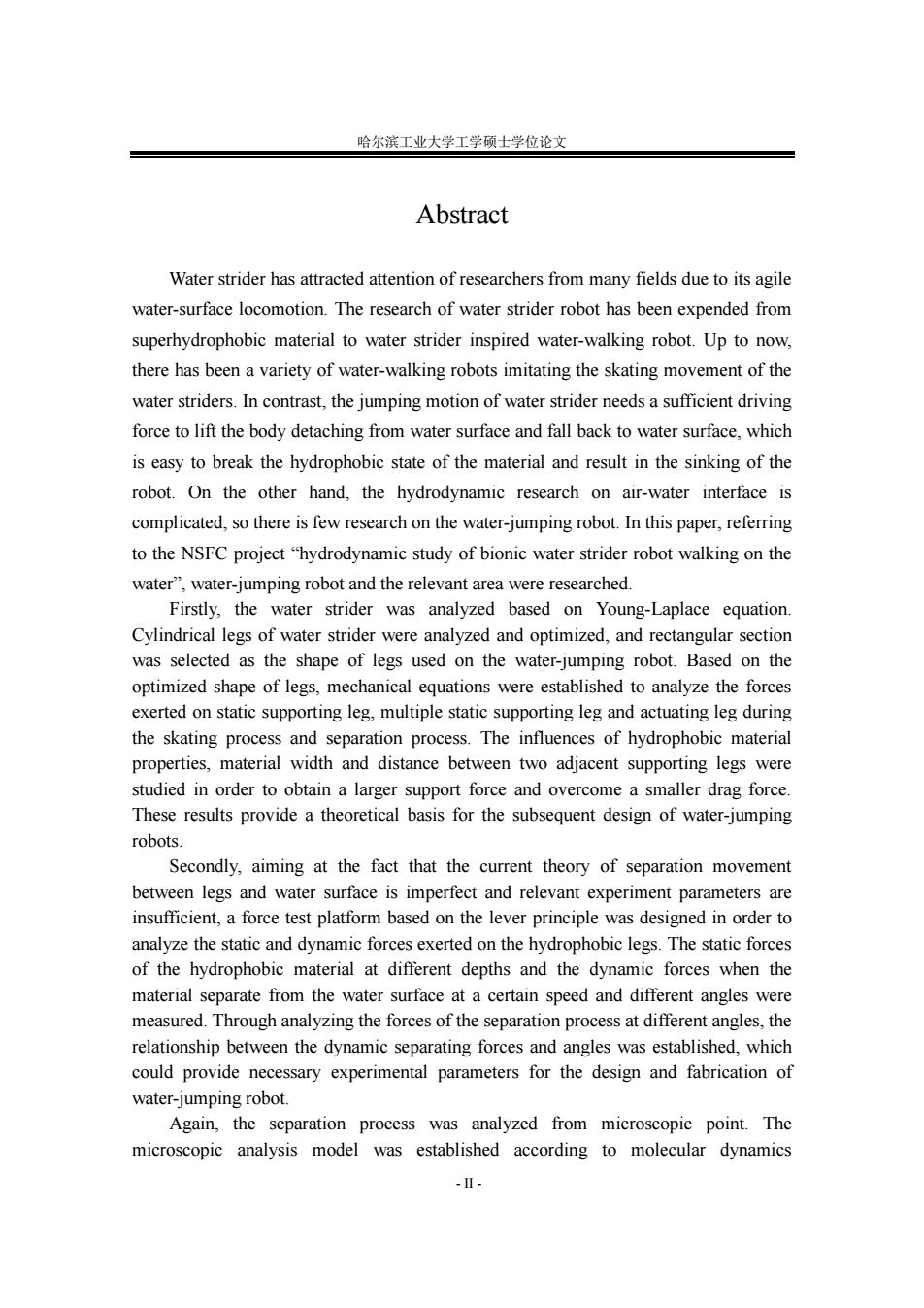
哈尔滨工业大学工学硕士学位论文 Abstract Water strider has attracted attention of researchers from many fields due to its agile water-surface locomotion.The research of water strider robot has been expended from superhydrophobic material to water strider inspired water-walking robot.Up to now, there has been a variety of water-walking robots imitating the skating movement of the water striders.In contrast,the jumping motion of water strider needs a sufficient driving force to lift the body detaching from water surface and fall back to water surface,which is easy to break the hydrophobic state of the material and result in the sinking of the robot.On the other hand,the hydrodynamic research on air-water interface is complicated,so there is few research on the water-jumping robot.In this paper,referring to the NSFC project "hydrodynamic study of bionic water strider robot walking on the water",water-jumping robot and the relevant area were researched. Firstly,the water strider was analyzed based on Young-Laplace equation. Cylindrical legs of water strider were analyzed and optimized,and rectangular section was selected as the shape of legs used on the water-jumping robot.Based on the optimized shape of legs,mechanical equations were established to analyze the forces exerted on static supporting leg,multiple static supporting leg and actuating leg during the skating process and separation process.The influences of hydrophobic material properties,material width and distance between two adjacent supporting legs were studied in order to obtain a larger support force and overcome a smaller drag force. These results provide a theoretical basis for the subsequent design of water-jumping robots. Secondly,aiming at the fact that the current theory of separation movement between legs and water surface is imperfect and relevant experiment parameters are insufficient,a force test platform based on the lever principle was designed in order to analyze the static and dynamic forces exerted on the hydrophobic legs.The static forces of the hydrophobic material at different depths and the dynamic forces when the material separate from the water surface at a certain speed and different angles were measured.Through analyzing the forces of the separation process at different angles,the relationship between the dynamic separating forces and angles was established,which could provide necessary experimental parameters for the design and fabrication of water-jumping robot. Again,the separation process was analyzed from microscopic point.The microscopic analysis model was established according to molecular dynamics -Ⅱ-
哈尔滨工业大学工学硕士学位论文 - II - Abstract Water strider has attracted attention of researchers from many fields due to its agile water-surface locomotion. The research of water strider robot has been expended from superhydrophobic material to water strider inspired water-walking robot. Up to now, there has been a variety of water-walking robots imitating the skating movement of the water striders. In contrast, the jumping motion of water strider needs a sufficient driving force to lift the body detaching from water surface and fall back to water surface, which is easy to break the hydrophobic state of the material and result in the sinking of the robot. On the other hand, the hydrodynamic research on air-water interface is complicated, so there is few research on the water-jumping robot. In this paper, referring to the NSFC project “hydrodynamic study of bionic water strider robot walking on the water”, water-jumping robot and the relevant area were researched. Firstly, the water strider was analyzed based on Young-Laplace equation. Cylindrical legs of water strider were analyzed and optimized, and rectangular section was selected as the shape of legs used on the water-jumping robot. Based on the optimized shape of legs, mechanical equations were established to analyze the forces exerted on static supporting leg, multiple static supporting leg and actuating leg during the skating process and separation process. The influences of hydrophobic material properties, material width and distance between two adjacent supporting legs were studied in order to obtain a larger support force and overcome a smaller drag force. These results provide a theoretical basis for the subsequent design of water-jumping robots. Secondly, aiming at the fact that the current theory of separation movement between legs and water surface is imperfect and relevant experiment parameters are insufficient, a force test platform based on the lever principle was designed in order to analyze the static and dynamic forces exerted on the hydrophobic legs. The static forces of the hydrophobic material at different depths and the dynamic forces when the material separate from the water surface at a certain speed and different angles were measured. Through analyzing the forces of the separation process at different angles, the relationship between the dynamic separating forces and angles was established, which could provide necessary experimental parameters for the design and fabrication of water-jumping robot. Again, the separation process was analyzed from microscopic point. The microscopic analysis model was established according to molecular dynamics